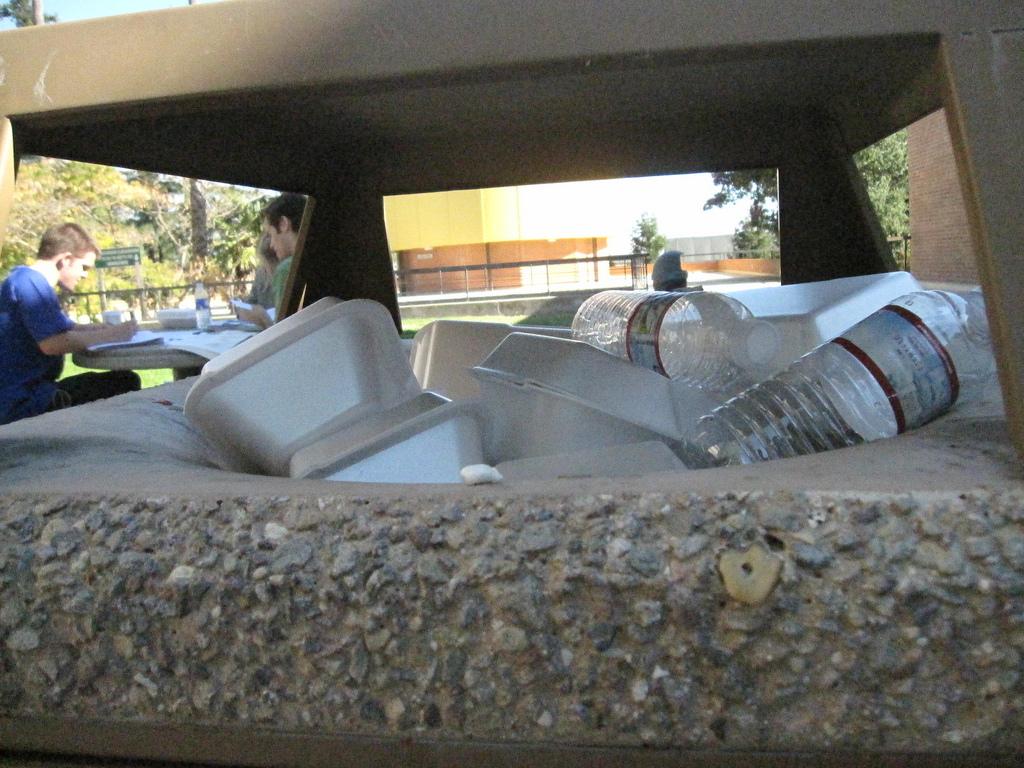ScrappingDVC is entering the Green Age, it seems, with the removal of environmentally-unfriendly materials at the top of its ecological agenda.
DVC’s Sustainability Committee has proposed a resolution to eliminate the use of Styrofoam containers from the Crow’s Nest, Basement Café and the cafeteria.
“The purpose is to encourage, forcefully, DVC Food Services to stop serving food and drink in Styrofoam containers,” said John Freytag, an instructor of oceanography and marine biology at DVC and Faculty Senate corresponding secretary, who has been working with the Sustainability Committee.
The 20-member Sustainability Committee, formed in 2005, is charged with promoting ideas for environmental awareness and sustainability on campus.
The committee is concerned largely with the health dangers that Styrofoam presents, particularly with hot food and drink, Freytag said. Styrofoam contains carcinogenic compounds, and its effects are detrimental to the human reproductive system, he explained.
Another worry for the committee is the environmental impact of using of Styrofoam products. Styrofoam is not biodegradable, creating a problem in landfills, and it breaks down into small pieces, which is often ingested by animals, Freytag said.
The Associated Students of DVC voted to endorse the Sustainability Committee’s resolution almost unanimously in their Nov. 23 meeting. The Faculty and Classified Senates will each vote on the item next week. If the resolution is approved, the governmental bodies will send their endorsement of the cause to the College Council, Faculty Senate President Laurie Lema said.
Getting rid of Styrofoam on campus is also a goal of ASDVC’s newly created ad-hoc Sustainability Committee, which is separate from the college’s committee but similar in its ideas to find ways to make the school greener. ASDVC’s other plans to pursue an environmentally friendly campus include the possible adoption of a new executive officer position, tentatively called the Minister of Environmental Affairs, who would promote ideas for the college’s environmental sustainability, ASDVC President Katerina Schreck said.
The cost of the switch to new non-Styrofoam products may limit the way DVC Food Services can implement it.
In an attempt to find a solution for the financial component, Freytag said, the committee is considering using paper products, instead of compostable ones, which are significantly more expensive than both paper and Styrofoam.
Even using paper products presents a sizable cost increase for Food Services. The added expense is the department’s main concern, George Delfabro said, food services manager.
To switch from Styrofoam to paper products would cost an estimated additional 40 to 50 cents for one “clamshell,” or food container, and one cup, Freytag said, noting that with thousands of meals sold, the cost adds up.
“My goal is to keep it below 50 cents, but it’s important to know that the cost will be passed on,” Freytag told the ASDVC in last week’s meeting.
Karen Ockander, a first-year DVC student, explained that although she would be willing to pay an extra 25 to 75 cents per meal for non-Styrofoam containers, she does not think that other students will think the cause is worth the extra cost.
“A lot of people are paying to go to school [by] themselves, so they probably want to avoid extra costs,” she said.
ASDVC discussed at the meeting the possibility of subsidizing the cost of the switch, but as of now, the financial aspect has not been resolved.
“As the ASDVC president, I am only going to recommend that the board consider this if the other senates are going to help subsidize the cost too,” Schreck said. “I do not believe that ASDVC, the students, should be the only ones paying for this, especially because everyone will be benefiting, and not only the students use the food services on campus.”
Contact Annie Sciacca at asciacca@theinquireronline.com





































































